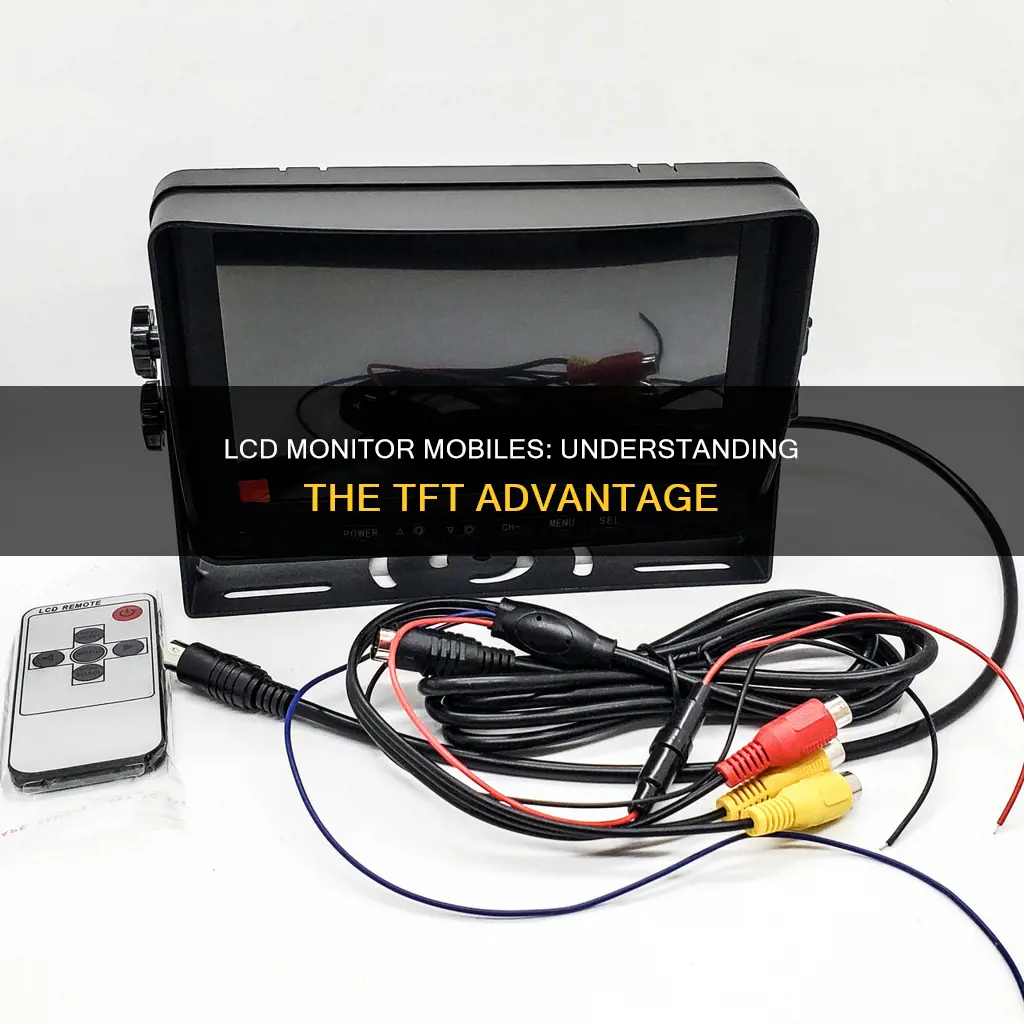
A thin-film-transistor liquid-crystal display (TFT LCD) is a type of liquid-crystal display that uses thin-film-transistor technology to improve image qualities such as addressability, brightness, and contrast. TFT LCD screens are used in television sets, computer monitors, mobile phones, and other devices. They are an active-matrix screen, where each pixel of the display is illuminated individually, providing the best resolution of all the flat-panel techniques.
| Characteristics | Values |
|---|---|
| Full Form | Thin-Film-Transistor Liquid-Crystal Display |
| Display Type | Flat-panel display |
| Display Device | Mobile devices, appliances, medical devices, instrumentation, aircraft, computer monitors, and televisions |
| Image Quality | Improved addressability and contrast |
| Resolution | Best resolution of all flat-panel techniques |
| Brightness | Sharper and brighter than a common LCD display |
| Speed | Faster than a regular LCD display |
| Motion | Smoother than a regular LCD display |
| Electricity Consumption | Higher than regular LCD screens |
| Cost | More expensive than regular LCD screens |
What You'll Learn

Thin-film-transistor technology
Thin-film-transistor (TFT) technology is a type of liquid-crystal display (LCD) that uses thin-film transistors to improve image qualities such as addressability, contrast, and speed. Each pixel in a TFT LCD panel is controlled by one to four transistors, and the screen is illuminated individually for each pixel. This active-matrix setup allows for the construction of high-resolution LCD screens with excellent contrast performance and the elimination of image blurring.
TFT displays are found in many applications, from mobile devices, appliances, and medical devices to aircraft, computer monitors, and televisions. They are also favoured by camera manufacturers as they allow a camera's LCD display to show high-resolution, colour-accurate reproductions of captured images. This enables photographers to make accurate judgments of their work without having to upload images to a device with a higher-quality display.
TFT displays are made using large sheets of transistors, each one controlled independently. They are more expensive than regular LCD screens, both in terms of upfront cost and operation, as they use more electricity. However, they offer a much higher-quality display, with sharper and brighter images, smoother motion, and faster refresh rates.
The circuit layout process of a TFT-LCD is similar to that of semiconductor products. However, rather than using crystalline silicon wafers, the transistors are made from a thin film of amorphous silicon deposited on a glass panel. This allows light to pass through easily, enabling thinner display designs.
Monitoring Children's Internet Usage: A Guide for Parents
You may want to see also

LCD displays
A thin-film-transistor liquid-crystal display (TFT LCD) is a type of liquid-crystal display that uses thin-film-transistor technology to improve image qualities such as addressability and contrast. TFT stands for "thin-film transistor", while LCD stands for "liquid crystal display". Both terms refer to the flat-panel display, or screen, of a computer monitor or television set.
TFT LCD screens are a type of active matrix LCD, which means that each pixel is controlled by one to four transistors. This is in contrast to passive matrix LCDs or simple, direct-driven LCDs, where the segments are directly connected to electronics outside the LCD. The addition of the thin-film transistor in LCD design vastly improved the use of LCDs across all market areas.
TFT displays are made using large sheets of transistors, each of which is controlled independently. A TFT screen is an "active-matrix" screen where each pixel of the display is illuminated individually. This results in a sharper and brighter display that refreshes more quickly and shows motion more smoothly than a regular LCD.
TFT displays are used in television sets, computer monitors, mobile phones, video game systems, personal digital assistants, navigation systems, projectors, and dashboards in some automobiles and motorcycles. They are also favoured by camera manufacturers because they allow a camera's LCD display to show high-resolution, colour-accurate reproductions of captured images.
Safely Packing and Moving Your LCD Monitor
You may want to see also

Advantages of TFT screens
TFT LCD screens, or thin-film transistor liquid-crystal displays, have many advantages. Firstly, they offer improved image qualities such as addressability, contrast, and colour display. The colour contrast, clarity, and brightness settings can be adjusted to accommodate specific application requirements, and TFT screens also have a much higher half-life than LED screens. TFT screens also offer excellent aspect ratio control, which contributes to better image clarity and quality by mapping out the number of pixels in the source image compared to the resolution pixels on the screen.
TFT screens are also incredibly versatile, offering a number of different interface options that are compatible with various devices, and they have fast and accurate response times. They are also space-efficient, as they can be placed anywhere in a workspace on a rotational mount so they can be turned in all directions. TFT screens minimise eye strain and have minimal energy consumption.
TFT screens are used in a wide range of applications, from mobile devices and appliances to medical devices, instrumentation, aircraft, computer displays, and TVs. The addition of the thin-film transistor in LCD design vastly improved the use of LCDs in all market areas.
Monitoring RF Usage: Powercell Insights and Strategies
You may want to see also

TFT screens vs LCD screens
TFT LCD screens are a type of liquid-crystal display that uses thin-film-transistor technology to improve image qualities such as addressability and contrast. Each pixel in the device has a thin-film transistor attached to it, which, when activated by an electrical current, makes contact with the pixels to produce an impeccable image quality on the screen. This is in contrast to passive matrix LCDs, which are directly connected to electronics outside of the LCD.
TFT LCD screens are used in television sets, computer monitors, mobile phones, video game systems, personal digital assistants, navigation systems, projectors, and dashboards in some automobiles and motorcycles. They are also used in rugged military LCD displays and monitors, as well as in marine displays.
TFT LCD screens offer excellent colour display, with top-notch colour contrast, clarity, and brightness settings that can be adjusted to accommodate specific application requirements. They also have a much higher half-life than LED screens and come in a variety of size configurations. Additionally, they offer minimal energy consumption, fast and accurate response times, and minimise eye strain.
However, one of the drawbacks of TFT LCD screens is that they have a higher price point than other displays. They also have disproportionate viewing angles and restricted utility due to glass paneling, which can be ineffective for outdoor use due to glares from natural lighting. TFT screens rely on backlighting to provide brightness and hence need built-in light-emitting diodes (LEDs) in their backlighting structure.
LCD screens, on the other hand, are fluidic display devices that use a crystalline-filled liquid to manipulate a rear illumination polarised source by means of an electrostatic field between two thin transparent metal conductors. They are used in calculators and other devices with simple displays. LCD screens have direct-driven image elements, which means that a voltage can be easily applied across a single segment of the display without interfering with the other segments.
While LCD screens are more affordable than TFT screens, they suffer from slower response times and image blurring when displaying moving images due to the slow rate of change between fluid states. They also have limited viewing angles and poorer colour reproduction compared to TFT screens.
Autosync Monitor and TV Sizes with HDMI: A Quick Guide
You may want to see also

Applications of TFT screens
TFT screens are used in a wide variety of applications due to their high image quality, responsiveness, and versatility. They are found in:
- Mobile devices
- Automotive displays
- Medical devices
- Industrial control systems
- Consumer electronics
- Television sets
- Computer monitors
- Video game systems
- Personal digital assistants
- Navigation systems
- Projectors
- Aircraft instrumentation
The addition of the thin-film transistor in LCD design vastly improved the use of LCDs in all market areas. TFT screens' ability to provide a clear and interactive display makes them ideal for applications where visual clarity and touch input are crucial.
Pixel Size: Monitor Viewing and Resolution Clarity
You may want to see also
Frequently asked questions
TFT stands for Thin-Film Transistor.
LCD stands for Liquid Crystal Display.
A TFT LCD uses thin-film-transistor technology to improve image qualities such as addressability and contrast. Each pixel is controlled by one to four transistors, which are illuminated individually.
TFT LCDs offer better resolution, contrast, and image speed than regular LCDs. They also allow for thinner display designs and improved viewing angles.
TFT LCDs are commonly used in mobile phones, computer monitors, and televisions. They are also found in medical devices, aircraft instrumentation, and cameras.







